Key takeaways
- Texture enhances the emotional and tactile quality of photographs, inviting viewers to engage more deeply with the image.
- Choosing the right surfaces and materials, along with contrasting textures, plays a crucial role in storytelling and composition.
- Lighting techniques, such as side lighting and backlighting, are essential for effectively highlighting and enhancing texture in photography.
- Post-processing requires a delicate balance to boost texture without compromising authenticity, ensuring images remain inviting and engaging.
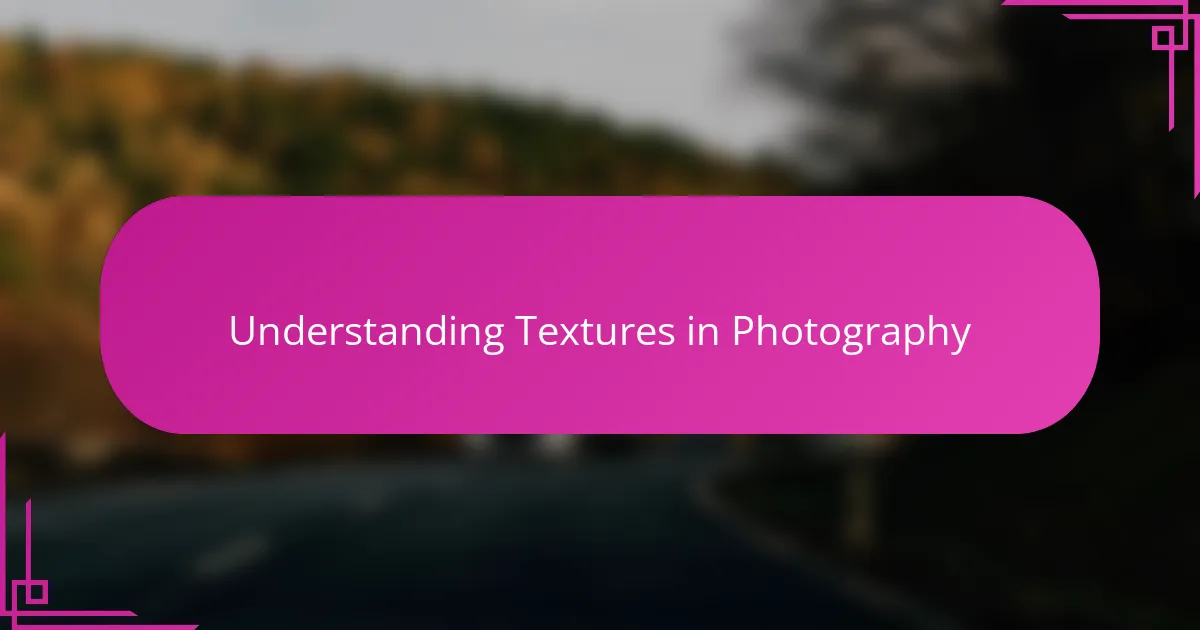
Understanding Textures in Photography
Texture in photography is more than just a visual element; it’s something I often find myself reaching for to give my images a tactile feel. Have you ever looked at a photo and almost felt the roughness of a tree bark or the softness of a worn fabric? That’s the power of texture—it invites viewers to experience the image on a deeper level.
When I first started experimenting with textures, I was surprised by how much they added to the storytelling. It’s like adding a secret ingredient that enriches the mood without overwhelming the photo. I ask myself every time: how can this texture help convey the emotion or theme I want to express?
Understanding texture means recognizing light and shadow’s role in defining it. Without subtle changes in lighting, textures can fall flat and lose their impact. I’ve learned that patience with natural light or careful manipulation of artificial sources transforms simple surfaces into captivating subjects.
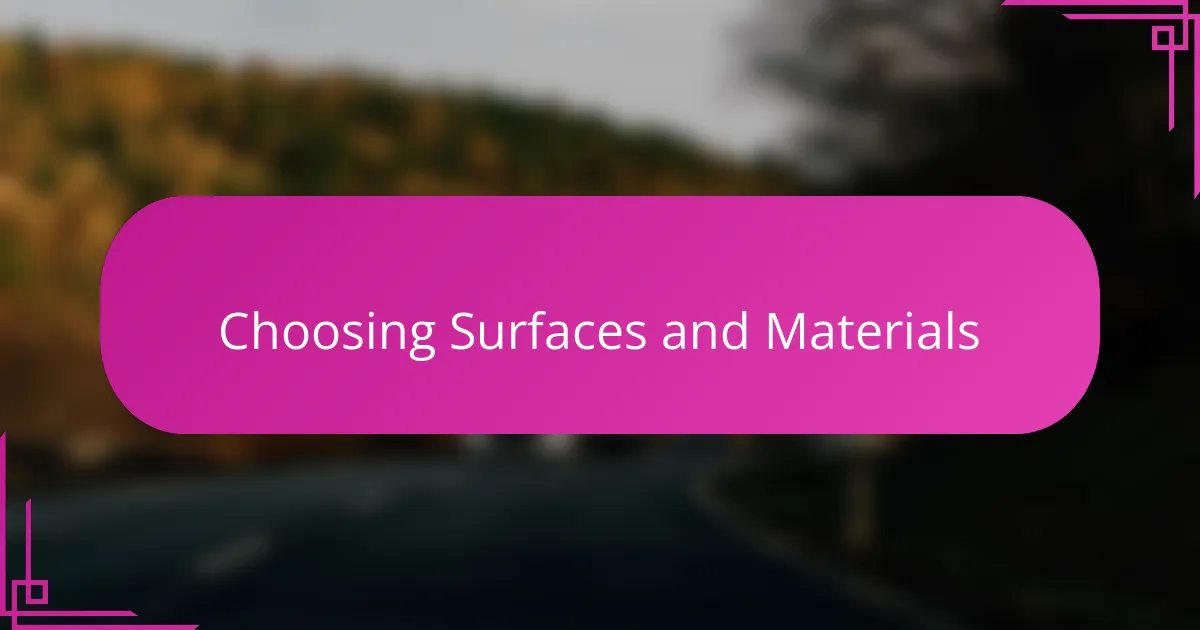
Choosing Surfaces and Materials
Selecting the right surfaces and materials is where much of the magic begins for me. I tend to gravitate toward elements that aren’t just visually interesting but also spark a feeling—like the gritty rust on an old metal door or the delicate weave of a handmade textile. Have you noticed how some surfaces almost tell their own story before you even press the shutter?
Sometimes, I find myself wandering through markets or exploring abandoned places just to discover textures that surprise me. One time, I stumbled upon cracked paint peeling from weathered wood, and that moment became the foundation for an entire series. It’s these personal encounters with materials that keep my work fresh and meaningful.
I’ve come to realize that not all textures work well together, so I carefully consider contrasts—rough versus smooth, organic versus man-made. This choice shapes the mood I’m aiming for and guides how I frame the shot. Do you ever pause to think about what the surface itself is communicating before clicking? I find that this question makes all the difference.
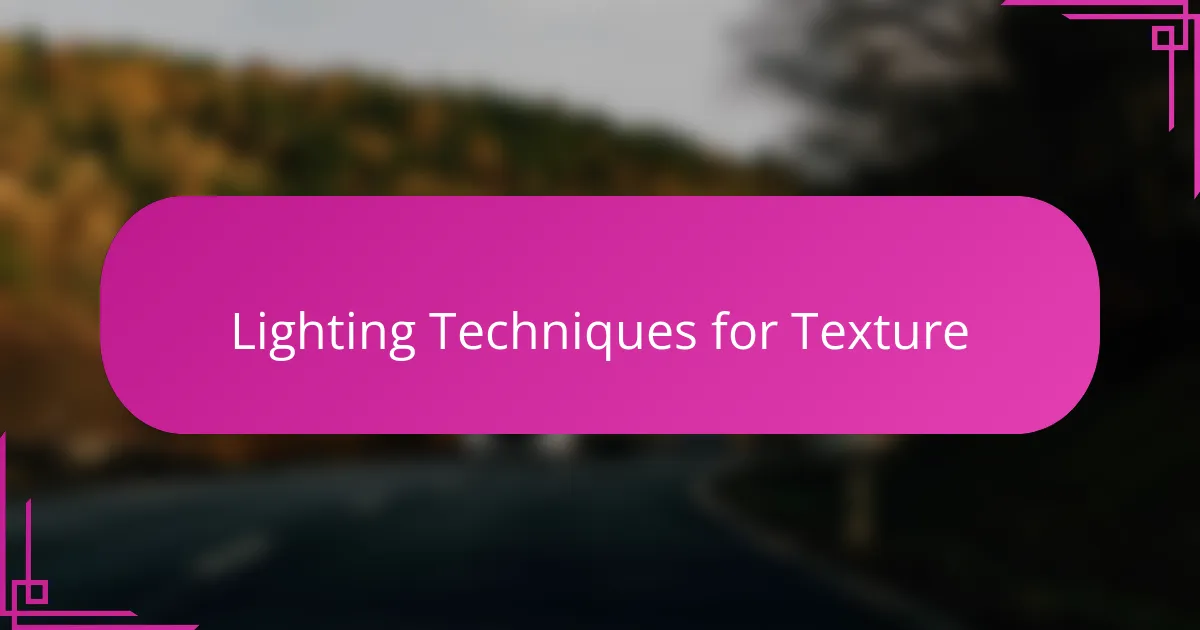
Lighting Techniques for Texture
Lighting can make or break the way texture appears in a photo. I’ve noticed that side lighting—where the light grazes the surface at an angle—really brings textures to life by creating shadows that emphasize every bump and crack. Have you ever seen a picture of weathered wood or wrinkled fabric that suddenly feels almost touchable? That’s the magic of directional light working its charm.
Sometimes, I play around with diffused light to soften textures, especially when I want a gentler, more subtle effect. For example, using a sheer curtain or a softbox helps me avoid harsh shadows while still revealing enough surface detail to keep the image interesting. It’s a balance between showing enough and not overwhelming the viewer with every tiny imperfection.
On occasion, I’ll use backlighting to highlight texture in a completely different way. When light passes through semi-transparent materials like leaves or fabric, it creates a glowing outline that adds depth and mystery. I remember shooting some dried leaves against the sun and being amazed at how the texture seemed to glow from within—it was like uncovering a hidden story told by light itself. Have you tried this approach? It definitely changes how you perceive familiar surfaces.
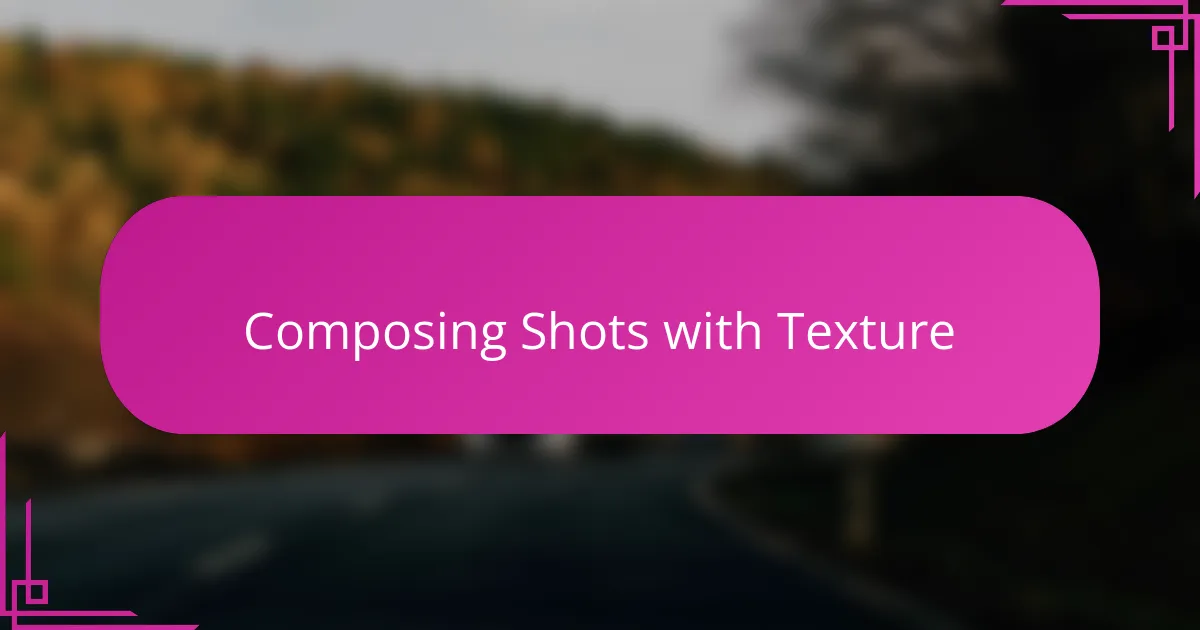
Composing Shots with Texture
When I’m composing shots with texture, I always think about the relationship between the texture and the overall composition. Does the texture lead the viewer’s eye in a certain direction? Sometimes, I position rough, tactile surfaces in the foreground to anchor the image and create a sense of depth. Have you noticed how a well-placed texture can almost pull you into the scene?
I also pay close attention to the balance between texture and other elements like color and shape. In one shoot, I deliberately framed a smooth, glossy surface next to a rugged stone wall to highlight their contrast—this juxtaposition made the textures feel even more vivid. It’s like texture becomes a character interacting with the rest of the frame.
There’s a moment I cherish when the texture tells its own story without overcrowding the shot. I recall capturing the peeling paint on an old fence where the worn layers spoke of time and decay, yet the empty space around it kept the composition calm and focused. Isn’t it fascinating how texture can both command attention and complement simplicity at the same time?
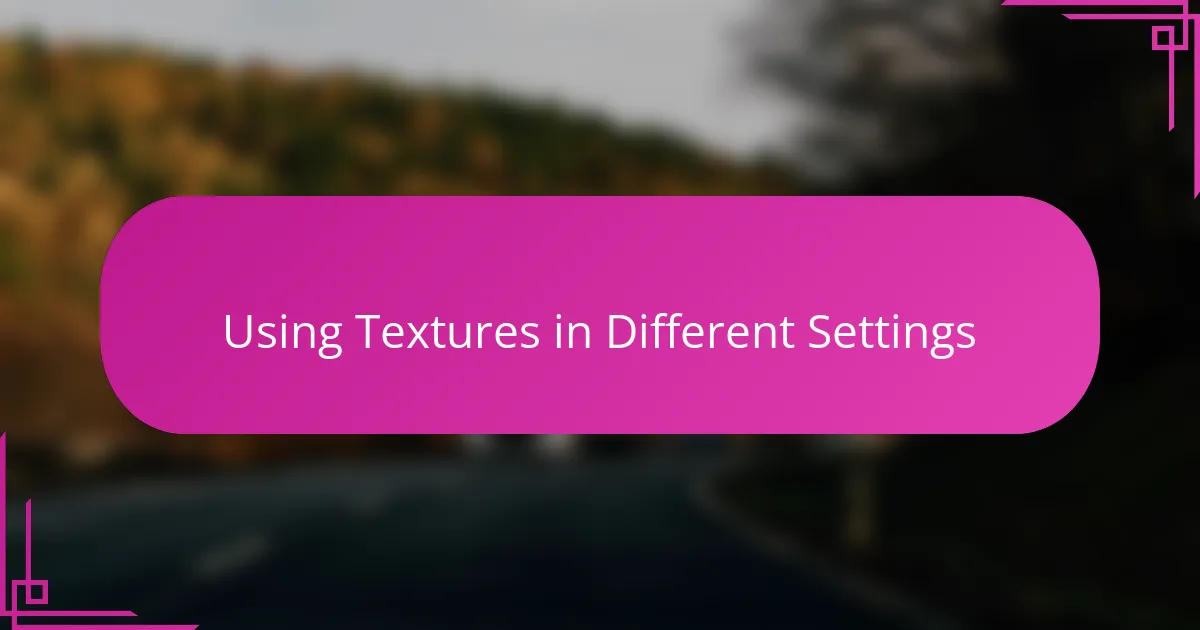
Using Textures in Different Settings
Different settings offer unique opportunities to explore texture in photography. For instance, urban environments often present gritty, raw surfaces—think cracked pavement or graffiti-covered walls—that convey a sense of ruggedness and history. I remember wandering through an old industrial district, captivated by how the peeling paint contrasted with sleek metal pipes, creating a tactile story of decay and resilience.
In natural settings, textures tend to be softer and more organic, from the delicate veins in leaves to the rough bark of trees. Capturing these details requires patience; one misty morning, I found that the dampness on moss amplified its texture beautifully, turning a simple shot into a sensory experience. Have you ever noticed how nature’s textures can evoke a quiet calm, almost like a visual whisper?
Indoors, textures can be controlled more deliberately through lighting and arrangement. I once worked on a project photographing textiles where the smooth silk was set against coarse burlap, each texture playing off the other under warm, directional light. It made me realize how different settings not only influence what textures are available but also how they can be enhanced or softened depending on the mood I want to create. Do you find it rewarding to tailor your approach based on the environment, too?
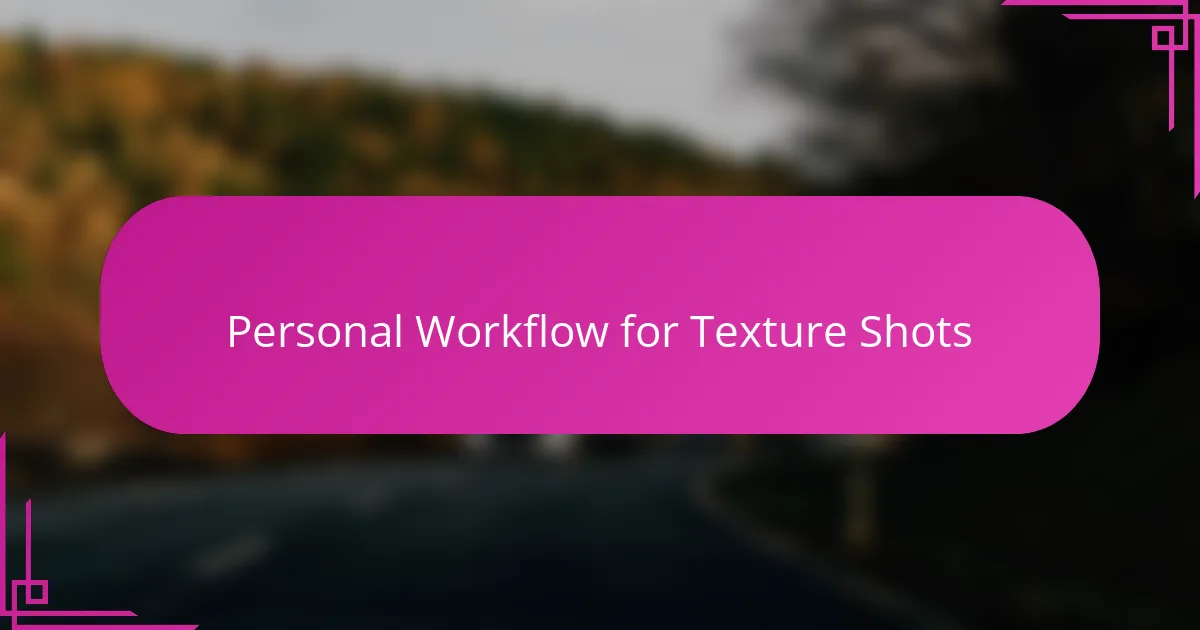
Personal Workflow for Texture Shots
My workflow for texture shots usually starts long before I pick up the camera. I spend time observing the surfaces around me, often touching them to understand their feel—that tactile connection helps me anticipate how the texture will translate in the frame. Have you ever tried letting your fingers explore a surface before shooting it? It’s surprisingly helpful in capturing authenticity.
When I’m ready to shoot, I like to take multiple angles and distances to see how the texture interacts with light and space. Sometimes a close-up reveals intricate details I didn’t initially notice, while a wider shot places the texture within a narrative context. I find this process keeps my images dynamic and emotionally engaging rather than static.
Post-shoot, I review my images with a critical eye toward how well the texture supports the mood I intended. Editing for texture is delicate—I might enhance contrast or sharpness just enough to bring out details without making the photo feel overworked. Isn’t there something satisfying about that balance where texture feels vivid yet natural? For me, that’s the sweet spot of my personal workflow.
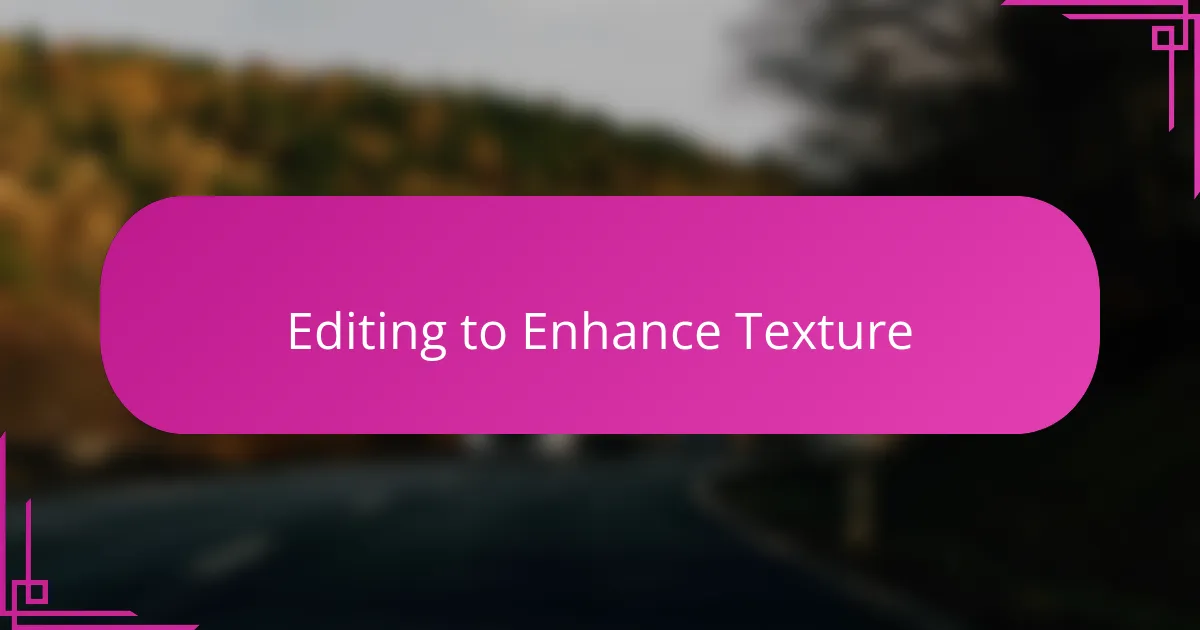
Editing to Enhance Texture
Editing to enhance texture is where I often find the magic truly happens. I like to subtly boost contrast and clarity, which can make the texture pop without looking artificial. Have you ever noticed how a tiny tweak in sharpness can transform a flat surface into something almost tangible?
Sometimes, I focus on localized adjustments rather than an overall edit. For instance, dodging and burning specific areas helps me emphasize the texture’s highlights and shadows, giving depth that draws the viewer’s eye. It’s like coaxing the surface to tell its story more clearly without shouting.
I’ve also learned to resist the temptation to overdo the edits. Too much sharpening or contrast can make textures harsh and distracting. Finding that delicate balance keeps the image feeling authentic and invites the viewer to explore the details at their own pace. Don’t you think preserving natural subtlety is part of what makes a texture-rich photo truly compelling?